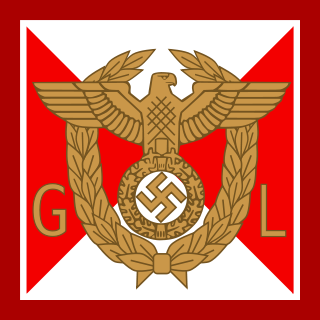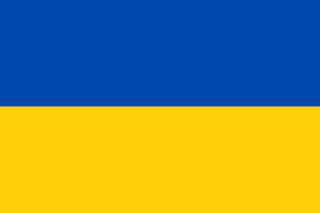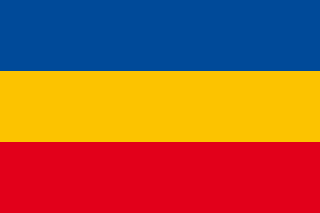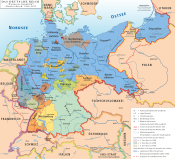
A Gauleiter was a regional leader of the Nazi Party (NSDAP) who served as the head of a Gau or Reichsgau. Gauleiter was the third-highest rank in the Nazi political leadership, subordinate only to Reichsleiter and to the Führer himself. The position was effectively abolished with the fall of the Nazi regime on 8 May 1945.

Hermann Esser was an early member of the Nazi Party (NSDAP). A journalist, Esser was the editor of the Nazi paper, Völkischer Beobachter, a Propaganda Leader, and a Vice President of the Reichstag. In the early days of the party, he was a de facto deputy of Adolf Hitler. As one of Hitler's earliest followers and friends, he held influential positions in the party during the Weimar Republic, but increasingly lost influence during the Nazi era.

Hinrich Lohse was a German Nazi Party politician and a convicted war criminal, best known for his rule of the Reichskommissariat Ostland, during World War II. Reichskommissariat Ostland comprised the states of Lithuania, Latvia, and Estonia, and parts of modern day Belarus.

Martin Mutschmann was the Nazi Regional Leader (Gauleiter) of the state of Saxony during the time of the Third Reich.

Rudolf Jordan was the Gauleiter in Halle-Merseburg and Magdeburg-Anhalt in the time of the Third Reich. After the war, he was sentenced to 25 years in a Soviet Union labour camp. He was released from the camp in October 1955, and died in Munich in 1988.
Wilhelm Friedrich Loeper was a German Nazi politician. He served as the Gauleiter in the Gau of Magdeburg-Anhalt and was the Reichsstatthalter of the Free States of Anhalt and Brunswick

Wilhelm Murr was a Nazi German politician. From 1928 until his death he was Gauleiter of Gau Württemberg-Hohenzollern, and from early 1933 held the offices of State President and Reichsstatthalter of Württemberg. During World War II he also rose to the rank of SS-Obergruppenführer in addition to his Party posts. At war's end he committed suicide with poison while in French custody.

This is a list of the counts, dukes, grand dukes, and prime ministers of Oldenburg.

The People's State of Hesse was one of the constituent states of Germany from 1918 to 1945, as the successor to the Grand Duchy of Hesse after the defeat of the German Empire in World War I, on the territory of the current German states of Hesse and the Rhineland-Palatinate. The State was established after Grand Duke Ernest Louis was deposed on 9 November 1918. The term "People's State" referred to the fact that the new state was a Republic and was used in the same manner as the term Free State, which was employed by most of the other German States in this period.

The Republic of Baden was a German state that existed during the time of the Weimar Republic, formed after the abolition of the Grand Duchy of Baden in 1918. It is now part of the modern German state of Baden-Württemberg.

The Free State of Brunswick was a state of the German Reich in the time of the Weimar Republic. It was formed after the abolition of the Duchy of Brunswick in the course of the German Revolution of 1918–19. Its capital was Braunschweig (Brunswick). In 1933 it was de facto abolished by Nazi Germany. The free state was disestablished after the Second World War in 1946.

The Free State of Schaumburg-Lippe was created following the abdication of Prince Adolf II of the Principality of Schaumburg-Lippe on 15 November 1918, following the German Revolution. It was a state in Germany during the Weimar Republic and Nazi Germany. The democratic government was suppressed during Nazi rule. At the end of the Second World War, the British military occupation government decreed on 1 November 1946 the union of Schaumburg-Lippe, Hannover, Braunschweig and Oldenburg to form the new state of Lower Saxony.

The Free State of Mecklenburg-Strelitz was a state of the Weimar Republic established in 1918 following the German Revolution which had overthrown the Grand Duchy of Mecklenburg-Strelitz. The state lasted until the Nazi Party (NSDAP) came to power in Germany and merged the state with the neighbouring Free State of Mecklenburg-Schwerin to form a united state of Mecklenburg on 1 January, 1934.

The Free State of Mecklenburg-Schwerin was a state in the Weimar Republic that was established on 14 November 1918 upon the abdication of the Grand Duke of Mecklenburg-Schwerin following the German Revolution. In 1933, after the onset of Nazi rule, it was united with the smaller neighbouring Free State of Mecklenburg-Strelitz to form the new united state of Mecklenburg on 1 January 1934.

The Free State of Lippe was created following the abdication of Prince Leopold IV of the Principality of Lippe on 15 November 1918, following the German Revolution. It was a state in Germany during the Weimar Republic and Nazi Germany. After the end of the Second World War, the Control Commission for Germany – British Element (CCG/BE) abolished the state of Lippe in January 1947 and incorporated it into the new German state of North Rhine-Westphalia that had been created three months earlier.

Carl Georg Röver was a German Nazi Party official. His main posts were as Gauleiter of Gau Weser-Ems and Reichsstatthalter of both Oldenburg and Bremen.

The Gau Weser-Ems, formed on 1 October 1928, was an administrative division of Nazi Germany from 1933 to 1945 in the core part of the Free State of Oldenburg, the state of Bremen and the western parts of the Prussian Province of Hanover. Before that, from 1928 to 1933, it was the regional subdivision of the Nazi Party in that area.
Georg Joel was a German Nazi Party politician. He was the long-serving Deputy Gauleiter of Gau Weser-Ems and also Minister-president of the Free State of Oldenburg throughout the Nazi regime. After the Second World War, he joined Neo-Nazi parties and served in the Landtag of Lower Saxony.
Willy Marschler was a German Nazi Party politician who served as one of the first two Nazis to hold ministerial office in a German State. He went on to be the Minister-President of Thuringia through most of the Third Reich.


















